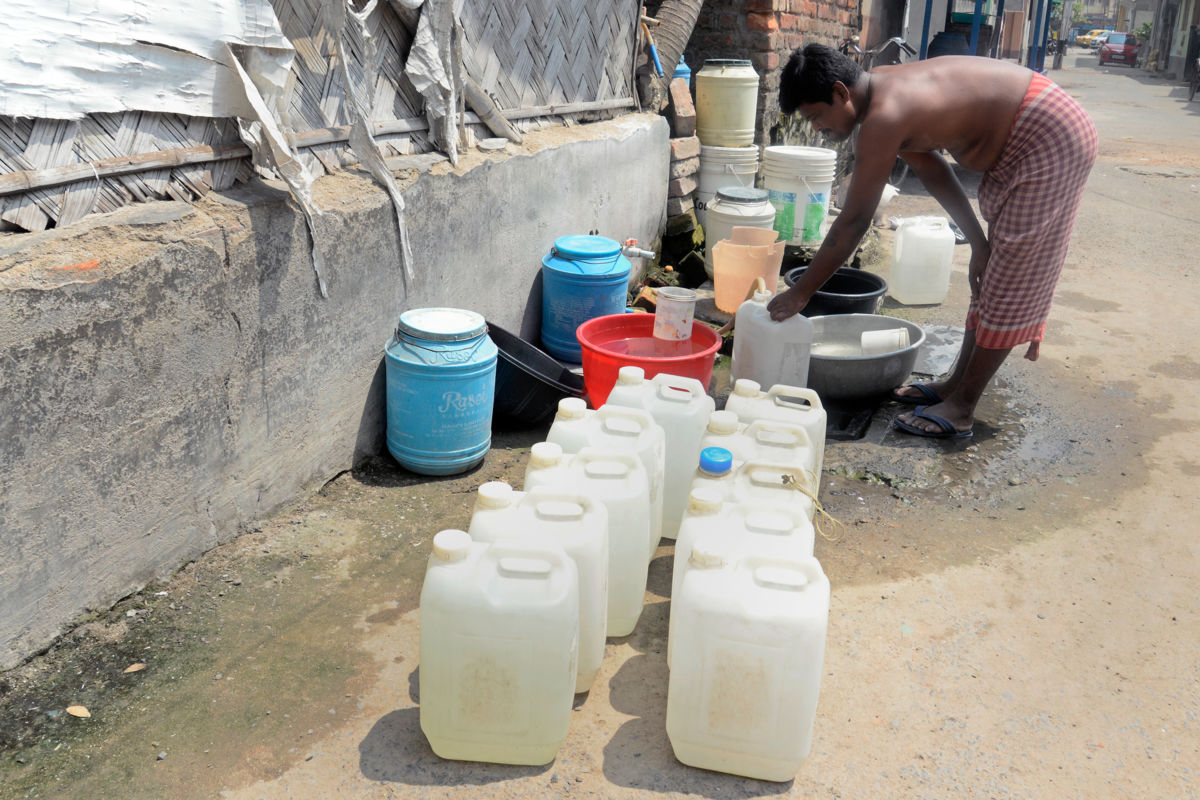
By Dahr Jamail, Truthout Published February 11, 2019

Planet or Profit
My friend Mark Oats, a farmer in Australia, recently sent this note to me:
Last night I looked through the Bureau of Meteorology App at the monthly rainfall figures for January, and temperatures.
The region around Byron Lismore has had 1.6 percent of average rainfall for January and is 2.6C degrees warmer than average. 98.4 percent less rain than normal. Virtually nothing — and hence the people, plant, animal and food pressures growing.
Then looking further afield across all capital cities and major regions. … Everywhere is down on average rainfall, except just one area — North Queensland — and that is only due to some late January flooding rains.
Melbourne 9.7 percent of normal rainfall. Adelaide 0 percent. Perth 43.1 percent. Hobart 0.8 percent. Sydney 47.7 percent. Brisbane 17.9 percent of normal rainfall.
After North Queensland, the next best is Western Sydney and Wollongong at around 70 percent of average normal rainfall — all of them well over average heat / temperatures, in many cases around 2C degrees[.] Canberra is 6.3C degrees above average for January.
Hobart is 4.2 C degrees above normal and is at less than 1 percent of normal rainfall.
Armidale, the region where we are, is about 80 percent of normal rainfall (70mm of 88mm average) but is a whopping 5.4C degrees above normal temperatures, averaging 32.2 for Jan with 26.8 normal average. Even the average minimum is 2C degrees higher than normal.
So there you go — stats and figures to show how extreme it is all over the country right now, and why fish, bats, chickens and insects are dying, vegetable growers are ploughing crops into the ground unable to afford to buy water any more, and cattle and sheep farmers are de-stocking, unable to feed them.
Now as we move into February — the hottest month of the year and no real rain forecast anywhere south of tropics.
Given the Arctic realities and the looming Blue Ocean Event (once the Arctic loses its summer sea ice, at which point global climate and weather patterns become profoundly destabilized) possibly as soon as 2022, things are really going to amplify.
Likely we will look back on January 2019 as when it was moderate and “easy” compared to the challenging heat and drought on the way.
Mark’s words should be a call to attention, and a call to action. The plight of farmers in Australia illustrates a larger reality: As planetary temperatures continue to increase and rainfall patterns shift due to human-caused climate disruption, our ability to grow crops and have enough drinking water will become increasingly challenged, and the outlook is only going to worsen.
Uncompromised, uncompromising news
Get reliable, independent news and commentary delivered to your inbox every day. Optional Member Code Your Email
We Have Been Warned
The most recent United Nations Intergovernmental Panel on Climate Change report warned of increasingly intense droughts and mass water shortages around large swaths of the globe.
But even more conservative organizations have been sounding the alarm. “Water insecurity could multiply the risk of conflict,” warns one of the World Bank’s reports on the issue. “Food price spikes caused by droughts can inflame latent conflicts and drive migration. Where economic growth is impacted by rainfall, episodes of droughts and floods have generated waves of migration and spikes in violence within countries.”In some places conflict is practically guaranteed.
Meanwhile, a study published in the journal Global Environmental Change, looked at how “hydro-political issues” — including tensions and potential conflicts — could play out in countries expected to experience water shortages coupled with high populations and pre-existing geopolitical tensions.
The study warned that these factors could combine to increase the likelihood of water-related tensions — potentially escalating into armed conflict in cross-boundary river basins in places around the world by 74.9 to 95 percent. This means that in some places conflict is practically guaranteed.
These areas include regions situated around primary rivers in Asia and North Africa. Noted rivers include the Tigris and Euphrates, the Indus, the Nile, and the Ganges-Brahmaputra.
Consider the fact that 11 countries share the Nile River basin: Egypt, Burundi, Kenya, Eritrea, Ethiopia, Uganda, Rwanda, Sudan, South Sudan, Tanzania and the Democratic Republic of Congo. All told, more than 300 million people already live in these countries, — a number that is projected to double in the coming decades, while the amount of available water will continue to shrink due to climate change.
For those in the US thinking these potential conflicts will only occur in distant lands — think again. The study also warned of a very high chance of these “hydro-political interactions” in portions of the southwestern US and northern Mexico, around the Colorado River.
India and Pakistan
Potential tensions are particularly worrisome in India and Pakistan, which are already rivals when it comes to water resources. For now, these two countries have an agreement, albeit a strained one, over the Indus River and the sharing of its water, by way of the 1960 Indus Water Treaty.
However, water claims have been central to their ongoing, burning dispute over the Kashmir region, a flashpoint area there for more than 60 years and counting.
The aforementioned treaty is now more strained than ever, as Pakistan accuses India of limiting its water supply and violating the treaty by placing dams over various rivers that flow from Kashmir into Pakistan.
In fact, a 2018 report from the International Monetary Fund ranked Pakistan third among countries facing severe water shortages, This is largely due to the rapid melting of glaciers in the Himalaya that are the source of much of the water for the Indus.For those in the US thinking these potential conflicts will only occur in distant lands — think again.
To provide an idea of how quickly water resources are diminishing in both countries, statistics from Pakistan’s Islamabad Chamber of Commerce and Industry from 2018 show that water availability (per capita in cubic meters per year) shrank from 5,260 in 1951, to 940 in 2015, and are projected to shrink to 860 by just 2025.
In India, the crisis is hardly better. According to that country’s Ministry of Statistics (2016) and the Indian Ministry of Water Resources (2010), the per capita available water in cubic meters per year was 5,177 in 1951, and 1,474 in 2015, and is projected to shrink to 1,341 in 2025.
Both of these countries are nuclear powers. Given the dire projections of water availability as climate change progresses, nightmare scenarios of water wars that could spark nuclear exchanges are now becoming possible.
As if to underscore all of this, even the US military recently warned that climate change is a worldwide threat. The military’s Worldwide Threat Assessment report warned that climate change and other types of environmental degradation threatened global stability because they are “likely to fuel competition for resources, economic distress, and social discontent through 2019 and beyond.”Yes, I’ll chip in
2019 is going to be an important year for us all…
…which is why we urgently need everyone reading this to take a moment to help us continue our work.
Unlike most news sites, we don’t run ads, have a paywall or sell your info. We rely on your support.
Please, help us keep fighting for a better future by making a tax-deductible donation right now. It takes seconds (we don’t even need your address) and every dollar helps.Copyright © Truthout. May not be reprinted without permission. Dahr Jamail
Dahr Jamail, a Truthout staff reporter, is the author of The End of Ice: Bearing Witness and Finding Meaning in the Path of Climate Disruption (The New Press, 2019), The Will to Resist: Soldiers Who Refuse to Fight in Iraq and Afghanistan (Haymarket Books, 2009), and Beyond the Green Zone: Dispatches From an Unembedded Journalist in Occupied Iraq (Haymarket Books, 2007). Jamail reported from Iraq for more than a year, as well as from Lebanon, Syria, Jordan and Turkey over the last 10 years, and has won the Izzy Award and the Martha Gellhorn Award for Investigative Journalism, among other awards. His third book, The Mass Destruction of Iraq: Why It Is Happening, and Who Is Responsible, co-written with William Rivers Pitt, is available now on Amazon. He lives and works in Washington State.More by this author…
